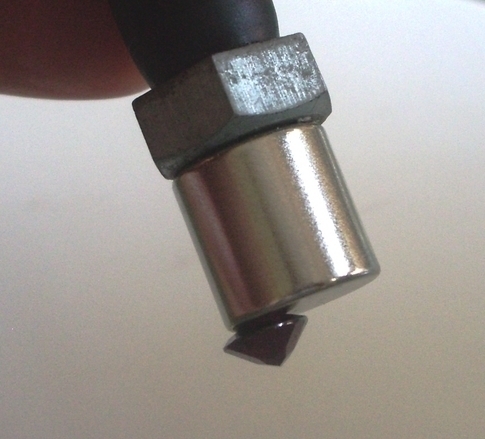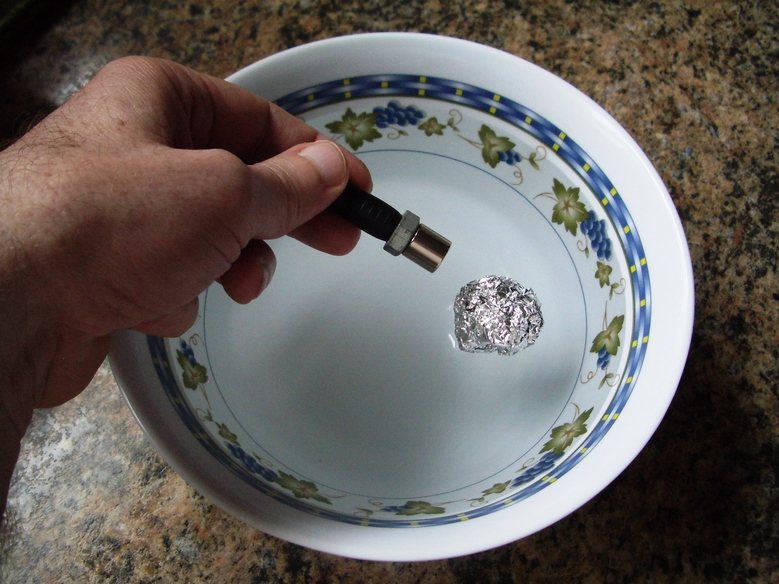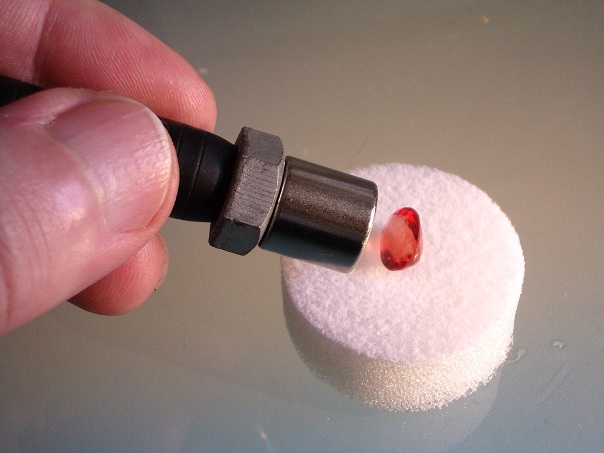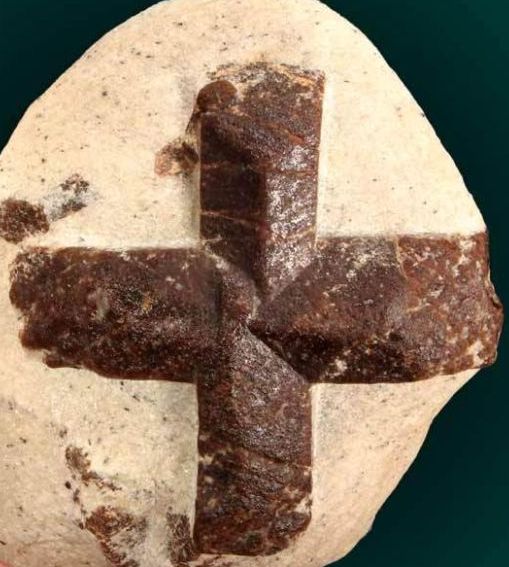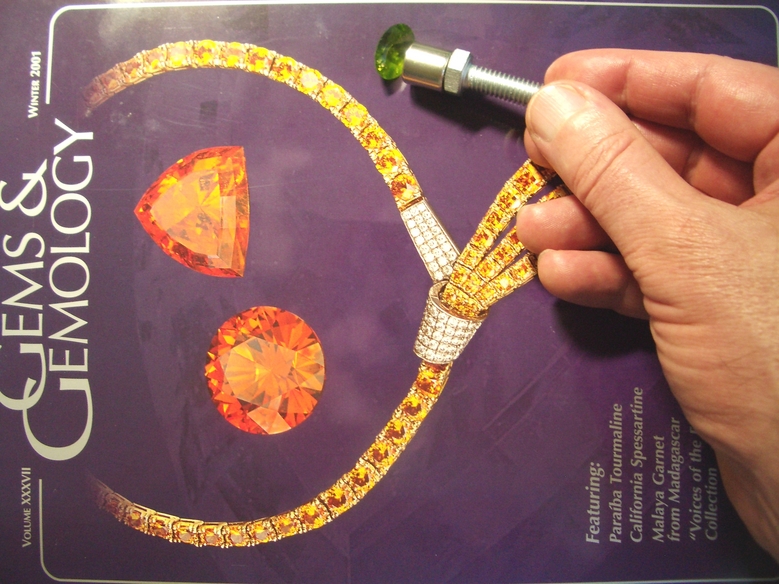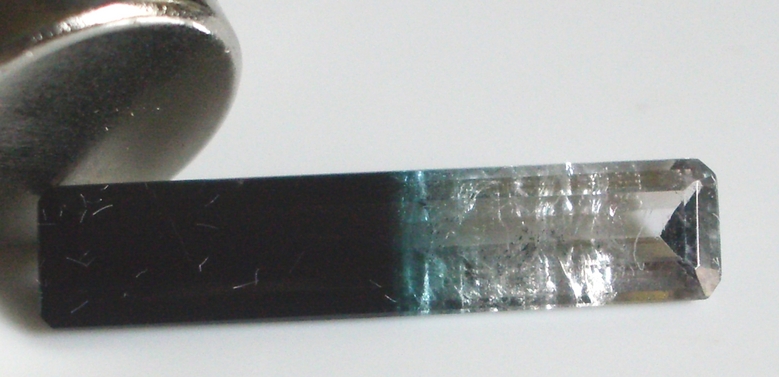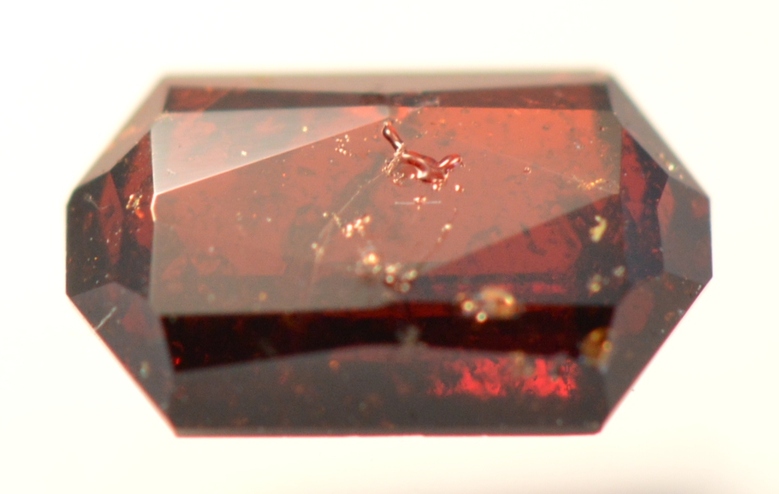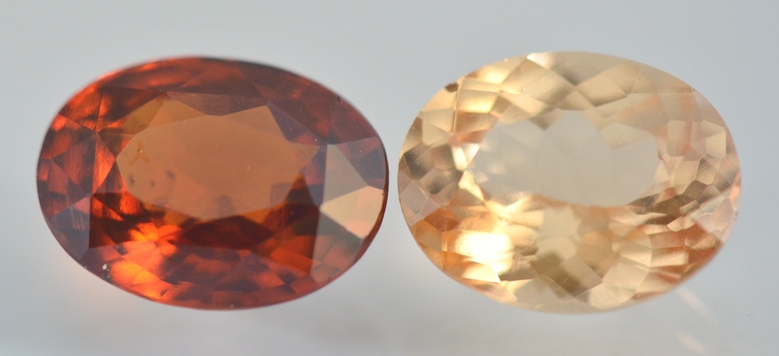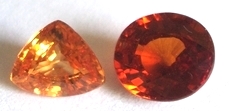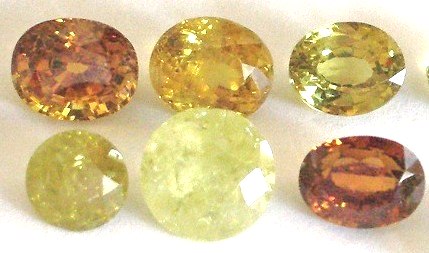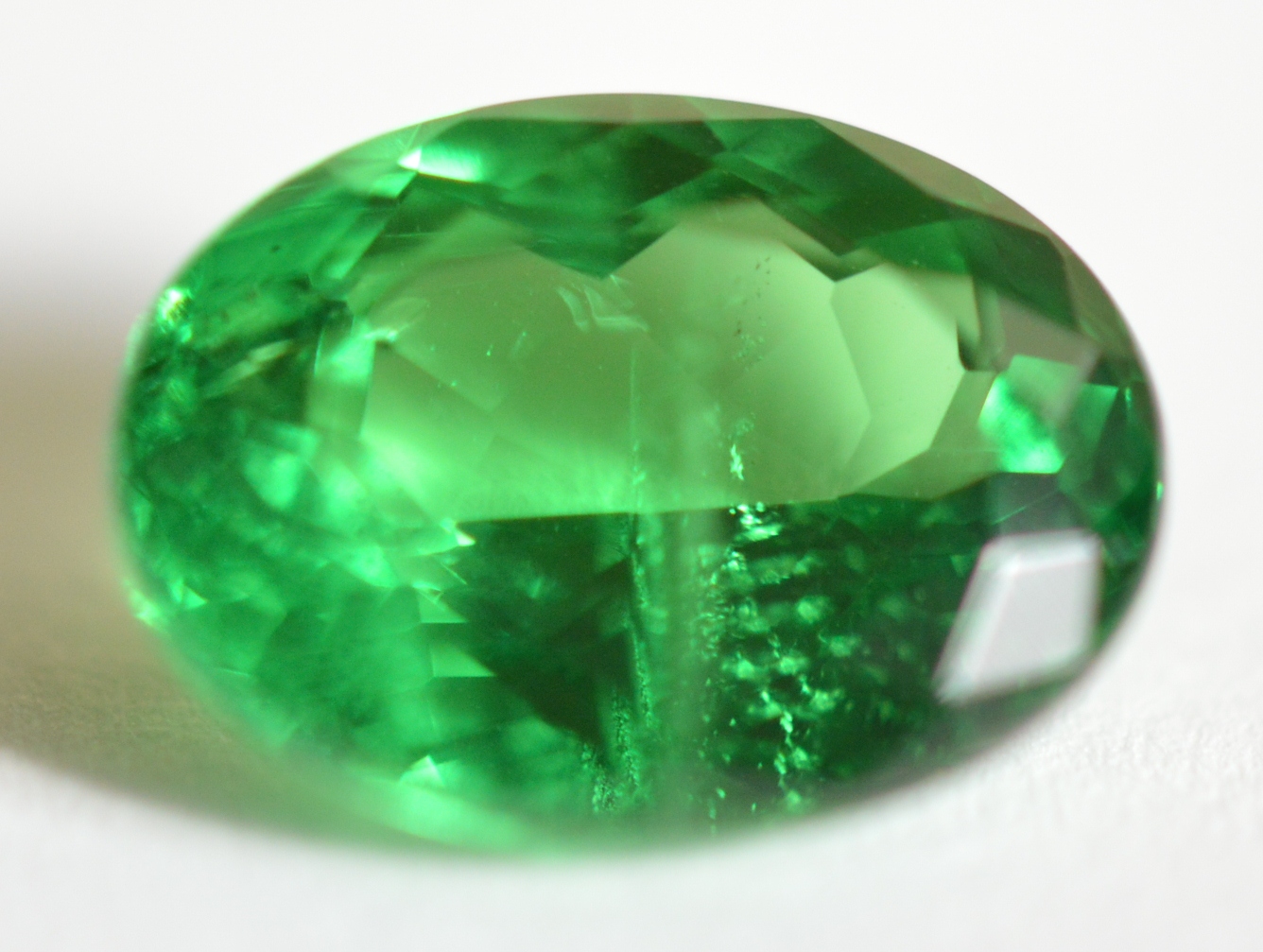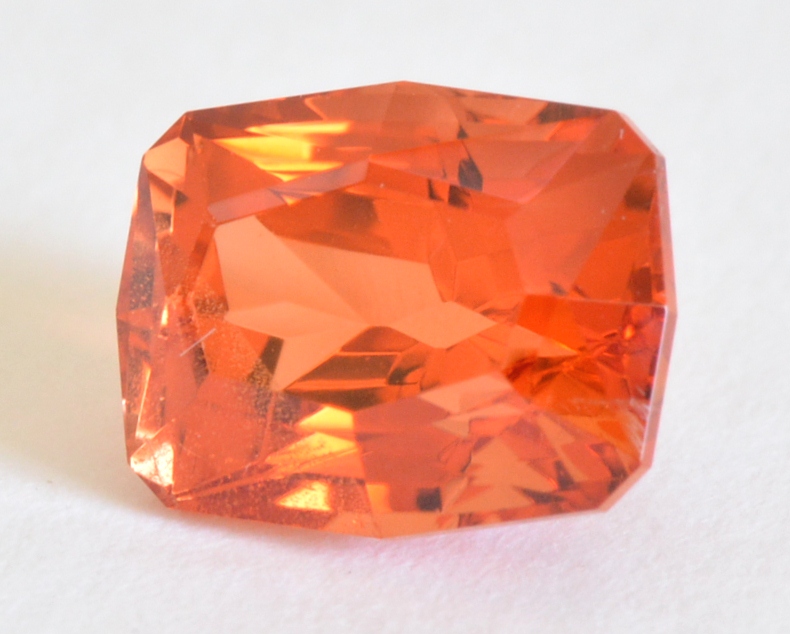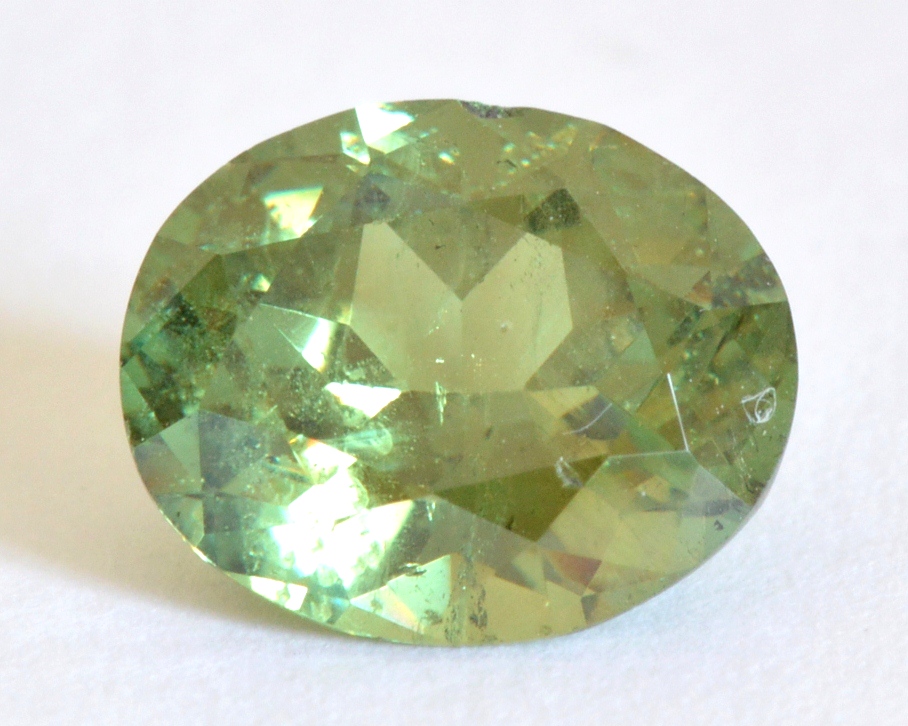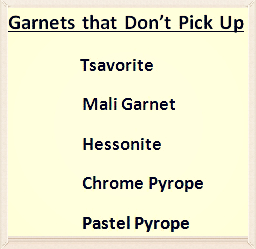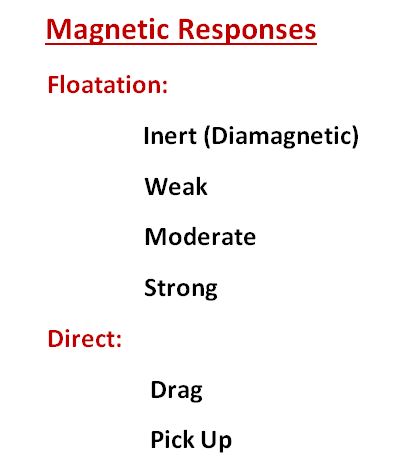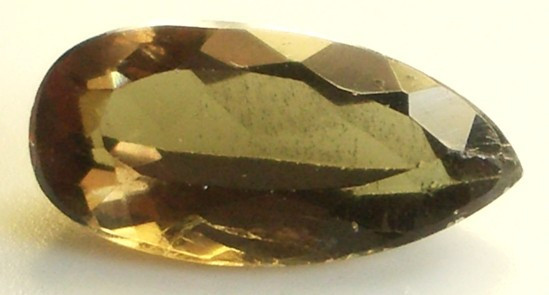Most Red Garnets Pick Up
Tsavorite Garnet
Hessonite Garnets
Drag Response
Pick Up Response
Inert (diamagnetic)
Weak
Moderate
Strong
Aluminum is Paramagnetic
© Kirk Feral 2009-present, All Rights Reserved. These materials may be duplicated for educational purposes only. No part of this website may be duplicated or distributed for profit, for commercial purposes, or for posting to another website, without the expressed written consent of the copyright holder.
Pick-Up Responses: A number of rare or unusual natural gems are magnetic enough that they will actually be picked up (PU) by N52 magnets. But of all the more common transparent minerals that are regularly faceted into gemstones, only Garnet gems pick up when the gems are heavier than one carat. This instantaneous response makes magnetic testing the fastest and easiest way to identify Garnet.
Most Garnet gems- specifically gems of the Pyrope, Almandine, Spessartine, and Andradite species- show a Pick Up response due to their very high iron and/or manganese content. Garnets of the Grossular species have lower iron content and don't pick up, and most Grossular gems require the Floatation Method for testing. Garnets of the Uvarovite species derive their green color and high magnetic susceptibility from a high concentration of chromium. Uvarovite crystals heavier than one carat are very rare, and these don't pick up, but they do show a Drag response with the Direct Method.
The most common Garnets are red, and as a rule, any natural transparent gemstone that is red and shows a Pick Up response can be identified as Garnet. Exceptions to this rule include a few rare examples of red non-Garnet transparent faceted gems such as Rhodochrosite and Rhodonite that also pick up. Among red Garnets, Pyrope Garnets show the weakest Pick-up responses. Red Chrome Pyropes and red Pastel Pyropes are rare examples of red Garnets that show only a Drag response. Besides red, many other color varieties of Garnet also show a Pick Up response.
If the raft is pushed away in the opposite direction from the magnet, you can designate this as an Inert response (I), which indicates the gem is diamagnetic. If the raft slowly follows the magnet as you pull the magnet away from it, you have a Weak response (W), indicating the presence of some paramagnetic metal(s). If the raft glides easily toward the magnet, you have a Moderate response (M). Rapid movement indicates a Strong response (S). Deciding which response you are seeing is somewhat subjective, but precise readings are neither possible nor necessary for this method. Moderate responses are usually the most difficult to discern, as they can overlap with either Weak or Strong responses.
On rare occasions, a gem will show no movement in either the push or pull direction. In such cases, the inert gem has just enough paramagnetism to cancel out the weak diamagnetism of the body of the gem. In this website, we use the term "inert" to refer to these rare inert responses, as well as to common diamagnetic responses.
Technique: Place the gem raft in the bowl away from the edges. The raft will have a tendency to adhere to the sides of the reservoir due to the surface tension of the water. If the gem is faceted, the table should sit face up on the raft (flat surfaces attract best). Avoid bumping the raft with the magnet or breathing directly on the raft, and keep the bowl away from air currents from fans and A/C ducts, or you will see movement unrelated to magnetism. Hold the magnet about a half inch (12 mm) from the gem and note what happens. If the raft moves toward the magnet, maintain the 1/2" testing distance as the gem and raft are pulled across the surface of the water.
Mali Garnets
Lack of a Pick Up response does not eliminate all Garnets. As mentioned above, gems of the Grossular Garnet species don't contain enough in iron to be picked up by a N52 magnet. Grossular Garnet includes Tsavorite, Mali Garnet, Hessonite, and some lesser-known varieties. Chromium-rich crystals of the Uvarovite Garnet species will not be picked up when they are over 1ct in weight. Uvarovite crystals are generally not faceted as gems due to their small size and lack of transparency.
Absence of a Direct response in green Garnet allows us to easily separate Tsavorite Garnet (Grossular) from green Demantoid (Andradite) of identical color. Only Demantoid picks up. Similarly, we can make a quick separation between orange Hessonite Garnet (Grossular) and orange Spessartine of identical color. Only Spessartine picks up. In addition, most Chrome Pyropes and Pastel Pyropes contain so little iron and/or manganese that they show only a Drag response, distinguishing them from all other Pyralspites (see the Garnet section for more information about these 2 unusual Pyrope Garnet varieties).
Floatation Method
A Red Garnet Impostor: Another strongly magnetic rare or secondary gemstone is Staurolite. When opaque, this reddish-brown mineral is commonly known as the Fairy Stone or Fairy Cross, because the natural twinning of its crystals at 90-degree angles makes a perfect cross. Transparent faceted gems look much like red Garnets, and due to high iron content, small transparent gems under 1 carat pick up with an N52 magnet (but larger gems only drag).
Opaque Staurolite
Transparent Staurolite
Staurolite is rarely found as transparent crystals, and such crystals are faceted only for collectors. Staurolite is idiochromatic, and the dark red color, magnetic susceptibility, refractive index and specific gravity all overlap with some low-iron Pyrope Garnet varieties. Under a polariscope, the double refraction of Staurolite can be confused with the anomalous double refraction of red Garnet. Fortunately, Staurolite is so rarely encountered as a transparent gemstone, it is very unlikely to be found impersonating Garnet during routine gem identification.
A slick high-gloss surface such as a magazine cover is ideal for direct testing because it reduces friction and shows drag responses slightly better than most standard surfaces like glass, wood, granite or even Formica. However, any clean smooth surface will work. Gems that show a near-drag response on a standard surface can be re-checked on a high-gloss surface for a more definitive drag response.
When using the direct method, make sure the gem is completely dry. Any water or refractive index fluid caught between the surface of the gem and the magnet can create a liquid seal that results in a false drag or pick-up response.
Drag Responses: A few highly magnetic gems can be dragged by a N52 magnet on a dry flat surface, but they are not magnetic enough to be picked up (except when very small). Among natural gems, there are only six transparent primary gemstones magnetic enough to drag when the direct method is applied. Two are Garnets and three are Tourmalines. These gems are:
The Direct method is the first step in magnetic testing of unidentified gemstones. A high-gloss magazine cover provides an ideal testing surface.
Orange Spessartine Garnets
Diagnostic: We will further qualify our use of the term diagnostic. When we say we can use a magnet to separate Garnets from all other common gemstones, we are referring to gemstones of natural origin. The laboratory-grown gems GGG (Gadolinium Gallium Garnet) and HPHT lab-created Diamond are transparent gems that can show a pick-up response. Based solely on magnetic response, red and green GGG might be mistaken for Almandine and Demantoid Garnet respectively. GGG is rarely encountered as a gemstone today, as this material has not been manufactured as a diamond simulant for some time. HPHT synthetic Diamonds can be manufactured in a number of colors, but because they are costly and only sold as Diamonds, HPHT synthetic Diamonds are not likely to be mistaken for Garnets.
We must also reiterate that we are focusing on the primary natural gemstones commonly found in the marketplace, gems that students of gem identification are likely to encounter. There are a few transparent exotic stones known only to collectors of rare gems and minerals that will also be picked up by a magnetic wand, even when above 1ct in weight. The most familiar of these are rare examples of transparent Rhodochrosite and Rhodonite gems (see next page), while some others include Dunilite, Eosphorite, Pyroxmangite, Siderite, Tantalite, Triplite, Triphylite, Vivianite and Xenotime.
Such rarely-seen gems are faceted from idiochromatic minerals that have high concentrations of manganese, iron or rare earth elements, and several are as magnetic as Garnet. If we relied solely on magnetic response and visual appearance, orange Triplite could be incorrectly identified as Spessartine Garnet (both are colored by manganese as Mn2+), and greenish Triphylite might be incorrectly identified as green Color Change Garnet (both contain iron and manganese).
Triphylite
The Floatation Method
For a quick demonstration of the floatation method, crumple a piece of aluminum foil into a ball, drop it into a bowl of water and hold your magnetic wand in front of it. Aluminum is weakly paramagnetic when it is in this pure solid metal form. The absence of friction allows the floating ball of foil to be drawn toward the neodymium magnet.
In a similar way, we can detect the weak magnetic attraction of the paramagnetic metals within gems, although such metals exist as ions rather than as solid metals. We use a gem raft and float the gem on top of the raft in a reservoir of water. The reservoir can be created from a bowl or shallow pan filled with tap water and made of plastic, glass, ceramic, tin or aluminum. This page demonstrates magnetic testing of loose gems rather than gems set in jewelry.
Bi-color Indicolite Tourmaline
A Drag response (D) is diagnostic for medium to dark blue "Indicolite" Tourmaline, as it is the only blue gem of average size that drags. Shown below (right) is a bi-color Tourmaline with blue" Indicolite" Tourmaline on one end and colorless Tourmaline at the other end. This gem provides an interesting demonstration of the drag response. The gem drags when a magnetic wand is brought to the blue end, but the gem shows no direct response at the colorless end.
Hessonite Garnet, Mali Garnet, Peridot, "Indicolite" Tourmaline, "Verdelite" Tourmaline, Yellow Tourmaline
Demantoid Garnet, a variety of Andradite, is the only transparent natural green gemstone heavier than 0.75 ct that picks up, and this response can be considered diagnostic for Demantoid. A rare exception is green Color Change Garnet, which has a modified grayish green color and also shows a pick-up response.
The Direct Method
The direct method of testing without floatation simply involves touching the magnet directly to the surface of a gem while the gem rests on a smooth dry flat surface. With faceted gems, we touch the flat table facet. We can use this method to first check an unidentified gemstone for magnetism. If the gem is highly magnetic, it will drag or pick up. But most magnetic gems will show no direct response to a magnet. Most gems must be tested with the floatation method in order for a magnetic response (paramagnetic or diamagnetic) to become visible.
A cylinder of gem jar foam makes an excellent raft on which to rest your loose gem. It doesn't matter that the foam soaks up a bit of water- it won't affect results unless it becomes heavily saturated after extended use. A square of Styrofoam also works well as a raft, and will not soak up water. For floating larger faceted gems, cabs and jewelry pieces, cut a large square of Styrofoam or bubble wrap to use as a larger raft. Foam and bubble wrap themselves are mostly air and don't show magnetic responses.
 Standardized Testing: The key to obtaining magnetic responses that are consistent between users and that fall with the ranges listed on the Magnetic Susceptibility Index is to use a common set of tools and techniques for testing. After experimenting with numerous magnets of different sizes and strengths, we determined that a ½” X ½” N52 grade neodymium magnet is an optimum size and strength for testing most gemstones. Magnets of smaller sizes and of lower grades such as N42 have different pull forces and can show different responses.
Standardized Testing: The key to obtaining magnetic responses that are consistent between users and that fall with the ranges listed on the Magnetic Susceptibility Index is to use a common set of tools and techniques for testing. After experimenting with numerous magnets of different sizes and strengths, we determined that a ½” X ½” N52 grade neodymium magnet is an optimum size and strength for testing most gemstones. Magnets of smaller sizes and of lower grades such as N42 have different pull forces and can show different responses.
The optimum testing distance between the magnet and the gem during floatation is about ½” (12mm). That approximate distance must be maintained as the gem is pulled toward the magnet. We hold the magnet closer to the gem only when we are trying to detect an extremely weak response. Otherwise, holding the magnet closer than 1/2" can result in a false Moderate response from a weakly magnetic gem, or a false Strong response from a moderately magnetic gem. Conversely, holding the magnet further than 1/2" from a gem can result in a diminished response, or no response at all.
Pale examples of any of the above gemstones may require floatation, and show only a weak to moderate response. Two rare varieties of Garnet- Chrome Pyrope and Pastel Pyrope- also show drag responses. Some uncommon secondary gemstones such as Axinite (Ferroaxinite and Manganaxinite species) also show drag responses.
Summary of Magnetic Testing Methods: When testing gems, the Direct Method can be applied first to check for strong magnetism. A pick-up response is generally diagnostic for Garnet when identifying common gems that are transparent and of average size. Large Garnet gems and Garnet roughs with irregular surfaces may not pick up, but most types will drag. For transparent gems other than strongly magnetic Garnet, Peridot, and Tourmaline, magnetic testing using the near-frictionless Floatation method is usually necessary to separate one gem type from another in order to narrow the possibilities for identification.
Floatation Videos: Click or Tap to Play
Except in the few cases when magnetic testing results are diagnostic for a particular gem, additional testing using other gem identification tools is usually required to arrive at a conclusive identification. This is true even for most Garnets when we want to determine the particular species or variety of Garnet.
Brown Andradite Garnet
Summary of Possible Magnetic Responses
Among the primary or common gemstones, a Pick-up response is diagnostic for Garnet, which means: if the gemstone is transparent and of average size (1ct to 4cts), no other test is required to positively identify the gem as Garnet. To determine the species of variety of Garnet, additional testing is usually required.
Man-made gems that show a Drag response include pink Cubic Zirconia (CZ), pink YAG and pink Glass, all of which contain the highly magnetic coloring agent erbium (a rare-earth metal). Manufacturers of a Glass-ceramic gem material called Nanosital, which is a newer addition to the gem market, combine erbium with other coloring agents to create colors other than pink, such as purple and yellow. These man-made Glass gems containing erbium also show Drag responses when floated.
Pink CZ and Purple Nanosital Glass
Doped with Erbium
Green Demantoid Garnet
Floatation
Brown Andradite Garnet is the only primary or common natural transparent brown gemstone of average size that picks up with an N52 magnet, and this is diagnostic for brown Andradite. Rarer brown stones that are faceted exclusively for collectors and also show a Pick Up response are brown Siderite, Bustamite, Eosphorite and Triphylite.
Orange Spessartine Garnets is the only orange transparent primary gemstone of average size that picks up, and this is diagnostic for Spessartine. Rare exceptions are orange Malaya Garnets and orange Color Change Garnets that contain a high percentage of Spessartine. Among non-garnets, orange Rhodochrosite is an example of a rare orange transparent gem that picks up. Note that Spessartine Garnet can also be red, in which case it cannot be distinguished from red Almandine Garnet by magnetic response alone.
Demantoid Picks Up
Triplite
Axinite
Magnetism in Gemstones
An Effective Tool and Method for Gem Identification
© Kirk Feral

